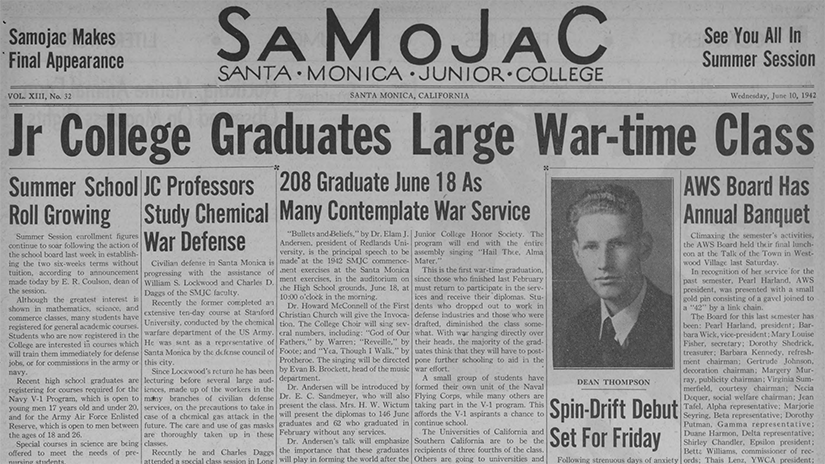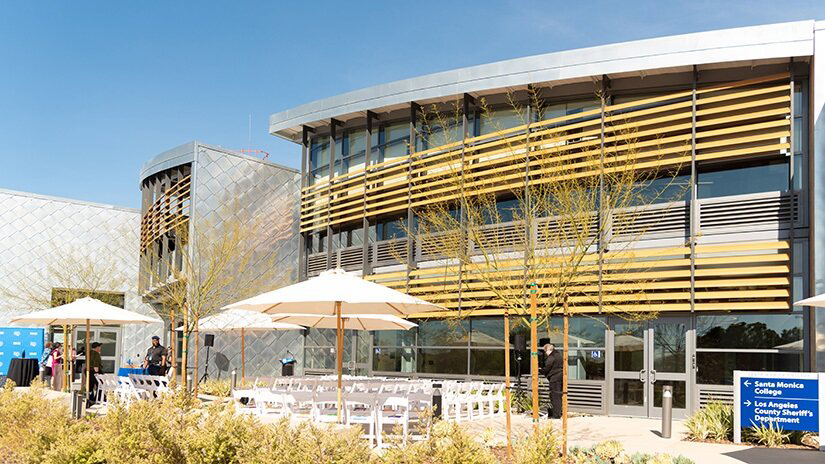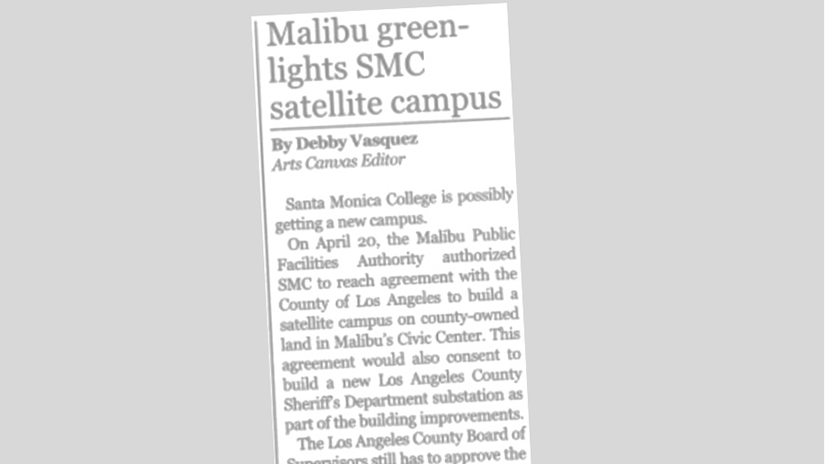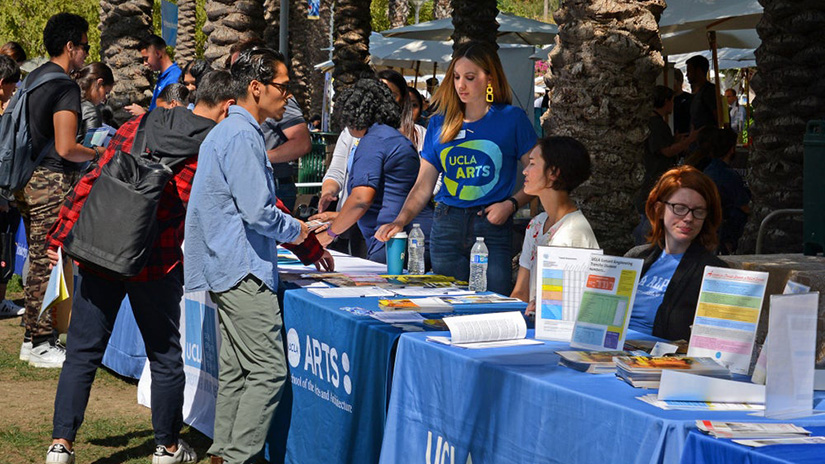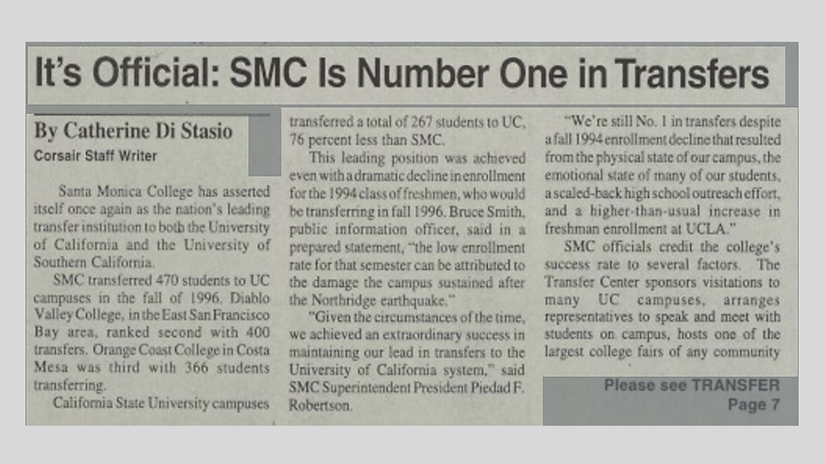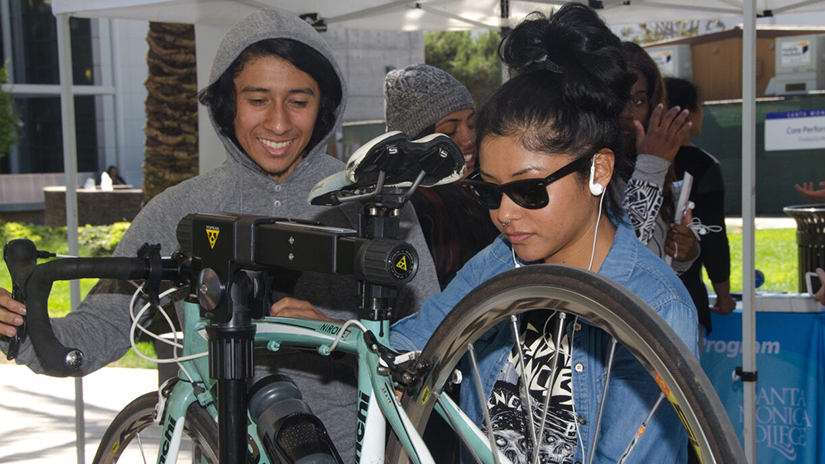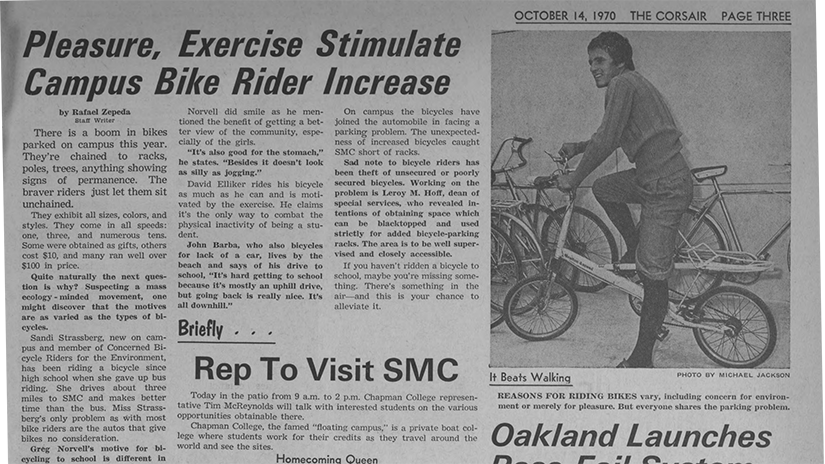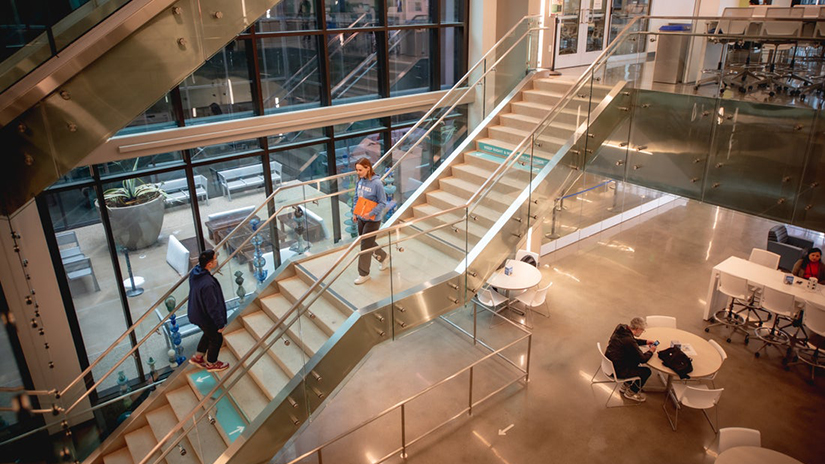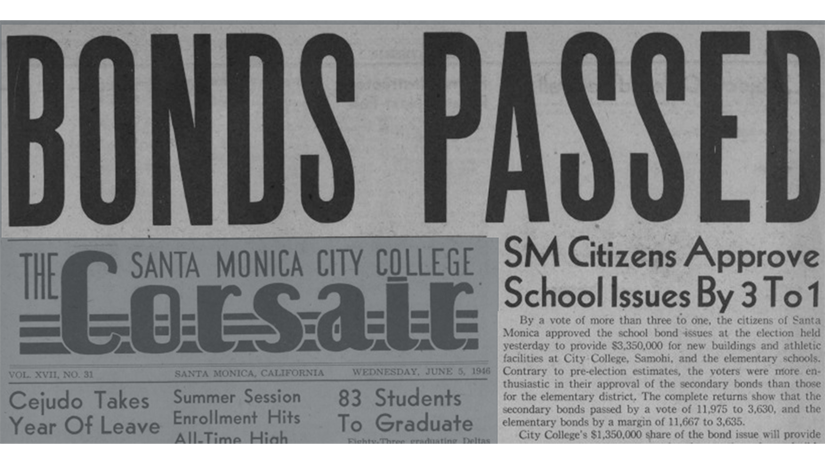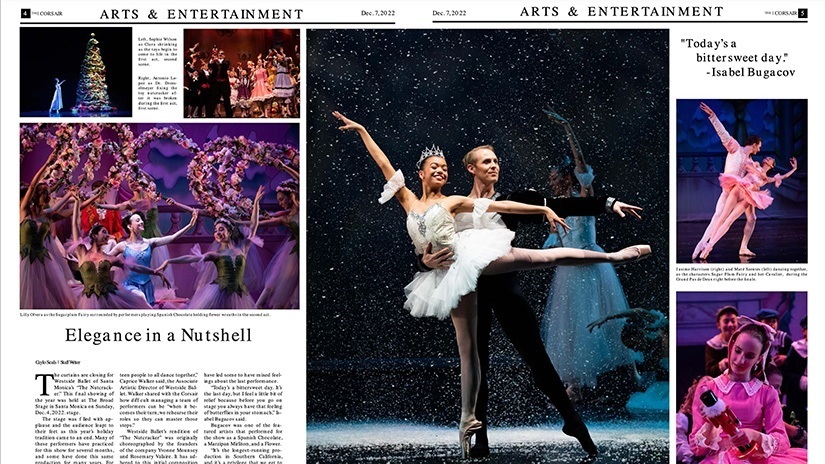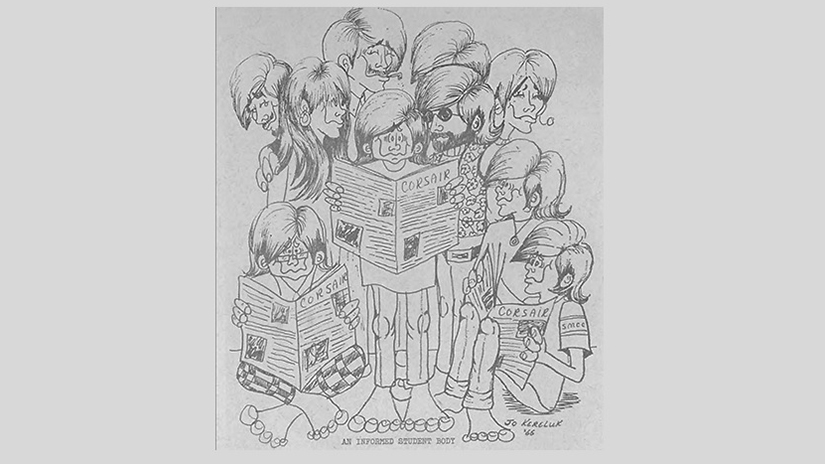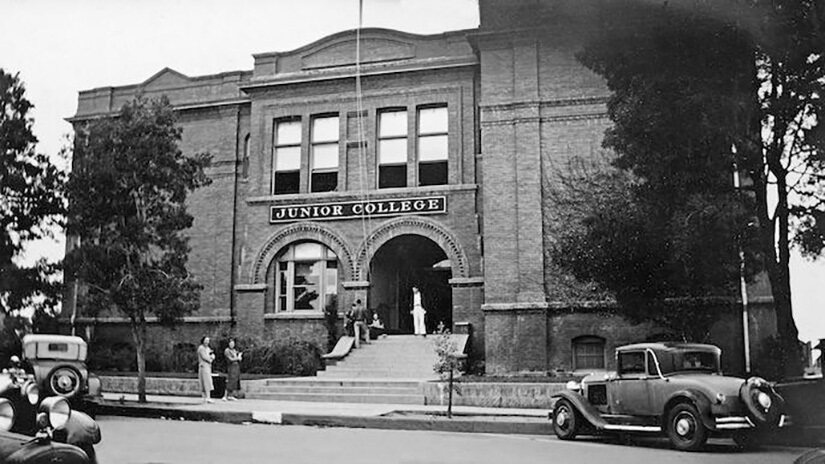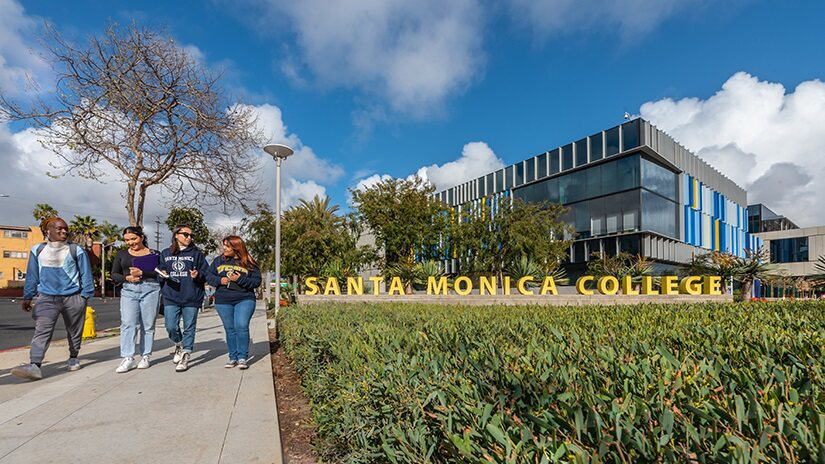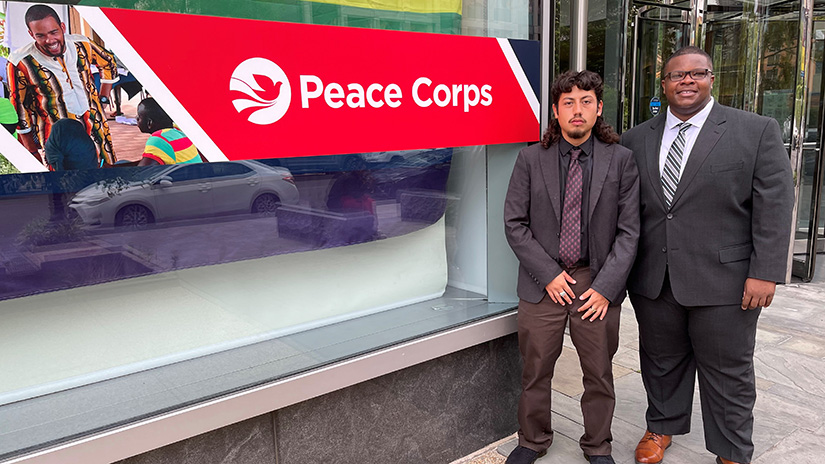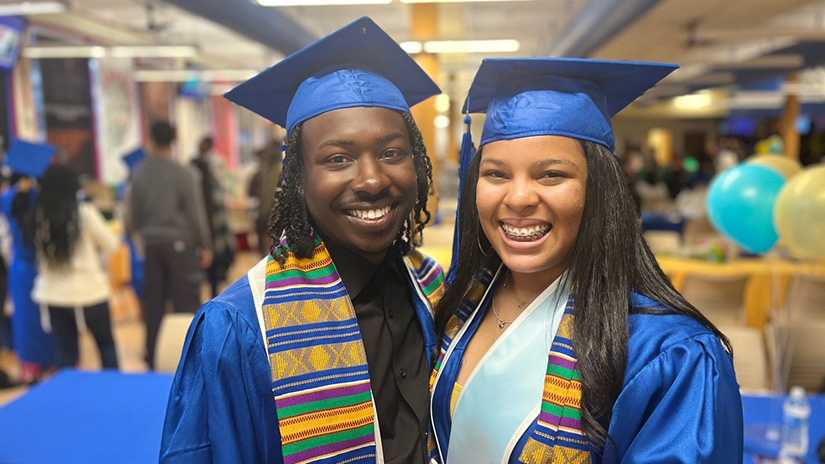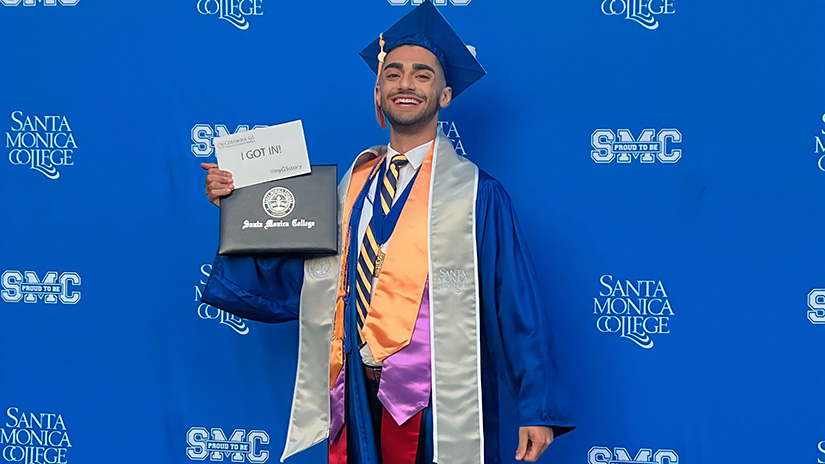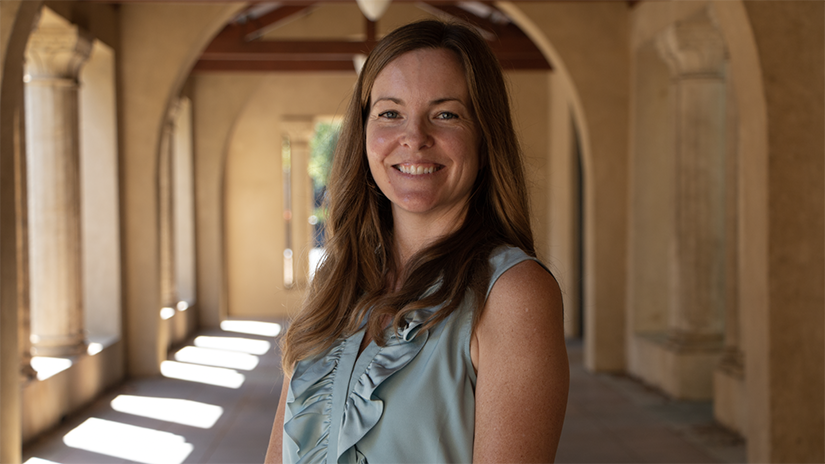A Walk Down (SMC's) Memory Lane

In 1929, Wall Street crashed, the first Academy Awards were held (believe it or not, a 15-minute ceremony!), and in Santa Monica, Calif. “Santa Monica Junior College”—which would eventually come to be known as “Santa Monica College”—was born. In its 94 years of existence, SMC has evolved, reinventing itself with the times and staying true to its reputation as a pioneer of the distinctly American community college movement.
Looking back on the major highlights of this past academic year, it occurred to the SMC In Focus editorial team that a frolic through the archives might yield up key milestones—markers that prove SMC’s storied history of innovation and change to be more than just, well, story. We turned to the digitized archives of the college’s award-winning student-run media outlet The Corsair. Available on the California Digital Newspaper Collection’s site, the archives offers up 82 years’ worth of Corsair issues, from 1929 through 2011—a total treasure trove of information (Thank you!). Take, for instance, a 1942 article highlighting the college’s graduating class, when “. . . with war hanging directly over their heads, the majority of the graduates think that they will have to postpone further schooling to aid in the war effort.”
Below, for each highlight of “today”—that is, from this past academic year—we present a look at an excerpt from a corresponding historical Corsair article that shows the long road SMC has traveled. Links to the full article are provided, too—we have taken no editorial liberties with the excerpts, and the excerpted text is presented exactly as it ran in The Corsair. The only corrections made are typographical, or to misspellings of names (to the best of our knowledge). Enjoy this walk down (SMC’s) memory lane!
Today: SMC Opens its First-Ever Malibu Campus
After nearly two decades of planning, Santa Monica College opened the doors to its first-ever campus in Malibu in Spring 2023. The gorgeous campus welcomed over 450 students who attended a total of 26 classes, encompassing for-credit academic courses, noncredit career pathway courses, and self-enrichment classes offered by Emeritus and Community Education.
In The Corsair, 13 Years Ago:
Malibu Greenlights SMC Satellite Campus (Wednesday, April 28, 2010)
[Read the original article in its entirety; by Debby Vasquez Arts Canvas Editor]
Santa Monica College is possibly getting a new campus.
On April 20, the Malibu Public Facilities Authority authorized SMC to reach agreement with the County of Los Angeles to build a satellite campus on county-owned land in Malibu's Civic Center. This agreement would also consent to build a new Los Angeles County Sheriff’s Department substation as part of the building improvements.
The Los Angeles County Board of Supervisors still has to approve the use of the land which would consist of 20,000 square feet for the college satellite and 5,700 square feet for the sheriff’s substation.
Approval by the board is likely, with much optimism among trustees and supervisors . . .
The money for this new satellite campus comes from a $135 million bond measure approved by Santa Monica and Malibu residents in 2004 that included $25 million for the educational facility in Malibu.
According to the press release published by the city of Malibu, the mayor of Malibu, Sharon Barovsky, has expressed great joy over this merger stating, "The Santa Monica College satellite campus will provide new educational opportunities for the community, and the sheriff’s substation will expand law enforcement's capacity to serve Malibu, especially during emergencies. Residents have long sought both of these projects, and we are so pleased to see they are moving forward."
The SMC Trustees also are happy with the union.
"We appreciate the support of the Malibu community and look forward to enhancing the local educational opportunities," said SMC Trustee Nancy Green[stein] in the press release.
SMC Trustee Rob Rader also commented in the press release, "This truly is an example of inter-governmental cooperation to maximize benefits and to save the taxpayers' money” . . .
If this plan is approved, the Malibu satellite campus will be the sixth SMC satellite campus. It is not known what this campus will emphasize in terms of programs and courses. According to the college, about 130 students are currently taking classes in Malibu at the Webster Elementary School in the Civic Center area, where general education, art, and photography classes are taught.
Today: SMC Marks 32-Year Streak as No.1 in Transfers to UC Campuses
Santa Monica College once again was #1 in transfers to the University of California! SMC was also #1 in African American and Chicanx/Latinx transfers to the UC system. SMC transferred 1,200 students to the UC System in 2021-22.The College also continues to be #1 in transfers to USC and Loyola Marymount University and continues to transfer more students to Columbia University than any other college west of the Mississippi.
In The Corsair, 26 Years Ago:
It's Official: SMC Is Number One in Transfers (Wednesday, April 30, 1997)
[Read the original article in its entirety; By Catherine Di Stasio, Corsair Staff Writer]
Santa Monica College has asserted itself once again as the nation's leading transfer institution to both the University of California and the University of Southern California.
SMC transferred 470 students to UC campuses in the fall of 1996. Diablo Valley College, in the East San Francisco Bay area, ranked second with 400 transfers. Orange Coast College in Costa Mesa was third with 366 students transferring.
California State University campuses transferred a total of 267 students to UC, 76 percent less than SMC . . . SMC officials credit the college's success rate to several factors. The Transfer Center sponsors visitations to many UC campuses, arranges representatives to speak and meet with students on campus, hosts one of the largest college fairs of any community college, and takes an active role in assisting students through the admissions process.
Brenda Johnson, assistant dean of transfer said, "SMC's commitment to transfer is unparalleled in the state. . .
. . . Besides the UC and USC statistics, SMC is also the leading transfer institution to Loyola Marymount University, and sends over 1,500 students each year to California State University campuses.
Some students have transferred to Dartmouth, Cornell, Stanford and Brown, as well. . .
Today: SMC’s 93rd Commencement Marks Largest Such Gathering in College History
Santa Monica College held the first fully in-person commencement ceremony since 2019, featuring U.S. Ambassador to the UN for Management & Reform Chris Lu as commencement speaker. The 93rd Commencement marked the largest such event in SMC’s history, attracting an impressive gathering of nearly 950 graduates and over 5,500 guests, all eagerly united in celebration. The ceremony was live streamed on the college’s website and SMC GO, providing broader accessibility to guests all over the United States and across the globe. A total of 8,557 degrees and certificates were awarded to 6,162 students.
In The Corsair, 81 Years Ago:
Jr. College Graduates Large War-time Class (Wednesday, June 10, 1942)
[Read the original article in its entirety; By Corsair Staff Writer]
"Bullets and Beliefs," by Dr. Elam J. Andersen, president of Redlands University, is the principal speech to be made" at the 1942 SMJC commencement exercises in the auditorium on the High School grounds, June 18, at 10:00 o'clock in the morning.
Dr. Howard McConnell of the First Christian Church will give the Invocation. The College Choir will sing several numbers, including: "God of Our Fathers," by Warren; "Reveille," by Foote; and "Yea, Though I Walk," by Protheroe. The singing will be directed by Evan B. Brockett, head of the music department.
Dr. Andersen will be introduced by Dr. E. C. Sandmeyer, who will also present the class. Mrs. H. W. Wictum will present the diplomas to 146 June graduates and 62 who graduated in February without any services. Dr. Andersen's talk will emphasize the importance that these graduates will play in forming the world after the war is over. The inevitable triumph of democratic governments will offer them a chance to be leaders in reshaping the future of the war-torn world.
Dr. Sandmeyer will announce the names of the new members of the Junior College Honor Society. The program will end with the entire assembly singing "Hail Thee, Alma Mater."
This is the first war-time graduation, since those who finished last February must return to participate in the services and receive their diplomas. Students who dropped out to work in defense industries and those who were drafted, diminished the class somewhat. With war hanging directly over their heads, the majority of the graduates think that they will have to postpone further schooling to aid in the war effort.
A small group of students have formed their own unit of the Naval Flying Corps, while many others are taking part in the V-l program. This affords the V-l aspirants a chance to continue school.
The Universities of California and Southern California are to be the recipients of three fourths of the class. Others are going to universities and colleges throughout the land. Engineering majors are increasing with an eye toward the war and the great industry that will follow. Women students are entering the field of nursing and other lines of medicine.
Today: SMC the Only Calif. Community College to Earn Silver Bicycle University Award
SMC earned a second consecutive Silver Bicycle Friendly University award from the League of American Cyclists. SMC remains the only California community college to earn a designation!
In The Corsair, 53 Years Ago:
Pleasure, Exercise Stimulate Campus Bike Rider Increase (Wednesday, October 14, 1970)
[Read the original article in its entirety; by Rafael Zepeda, Staff Writer]
There is a boom in bikes parked on campus this year. They're chained to racks, poles, trees, anything showing signs of permanence. The braver riders just let them sit unchained.
They exhibit all sizes, colors, and styles. They come in all speeds: one, three, and numerous tens. Some were obtained as gifts, others cost $l0, and many ran well over $l00 in price.
Quite naturally the next question is why? Suspecting a mass ecology - minded movement, one might discover that the motives are as varied as the types of bicycles.
Sandi Strassberg, new on campus and member of Concerned Bicycle Riders for the Environment, has been riding a bicycle since high school when she gave up bus riding. She drives about three miles to SMC and makes better time than the bus. Miss Strassberg's only problem as with most bike riders are the autos that give bikes no consideration.
Greg Norvell's motive for bicycling to school is different in that he has no choice, for he does not own a car. His main objection is that he feels it is hard work, partly because his bike is a three speed . . . "It's also good for the stomach," he states. "Besides it doesn't look as silly as jogging” . . . John Barba, who also bicycles for lack of a car, lives by the beach and says of his drive to school, "It's hard getting to school because it's mostly an uphill drive, but going back is really nice. It's all downhill."
. . .
If you haven't ridden a bicycle to school, maybe you're missing something. There's something in the air—and this is your chance to alleviate it.
Today: Voters Approve $375 Million Measure SMC in Nov. 2022
In November 2022, local voters approved Measure SMC allowing for the issuance of $375 million in general obligation bonds to make possible much-needed updates to existing SMC career training facilities, create new housing for eligible low-income students, and provide technology upgrades to meet emergent needs in the post-pandemic world.
In The Corsair, 77 Years Ago:
SMC Citizens Approve School Issues by 3 to 1 (Wednesday, June 5, 1946)
[Read the original article in its entirety; By Corsair Staff Writer]
By a vote of more than three to one, the citizens of Santa Monica approved the school bond issues at the election held yesterday to provide $3,350,000 for new buildings and athletic facilities at City College, Samohi, and the elementary schools. Contrary to pre-election estimates, the voters were more enthusiastic in their approval of the secondary bonds than those for the elementary district. The complete returns show that the secondary bonds passed by a vote of 11,975 to 3,630, and the elementary bonds by a margin of 11,667 to 3,635.
City College's $1,350,000 share of the bond issue will provide for the erection of new buildings and the removal of the best classrooms now in use to the new campus site, which is located at 16th Street and Pico Boulevard . . .
Today: SMC’s The Corsair & its Staff Win Dozens of Awards
The college’s student-run media outlet The Corsair and its staff won approximately three dozen awards from the Society of Professional Journalists, College Media Association, Associated Collegiate Press and the Journalism Association of Community Colleges
In The Corsair, 57 Years Ago:
Newspapers Serve Students (Wednesday, October 12, 1966)
[Read the article in its entirety; By Corsair Staff Writer]
Amidst the hurry to class on Wednesdays, students usually grab a copy of the Corsair. They take it, read a story or two and glance at the photographs.
But what would happen without a newspaper? Club attendance would drop, many clubs would disband altogether and assemblies and events would have small turnouts.
Informing the students of upcoming events makes up a college newspaper's main purpose. Students want to know about what is happening around them. Without a newspaper, the campus either would be littered with handbills or students would have to find out on their own what is happening.
Another method of informing the reader is the editorial, used for political issues or for other issues concerning students.
The newspaper prints facts from all sides and allows the reader to make up his own mind. The value of this method is that the newspaper has access to facts which the reader does not have. Thus the paper informs the student and creates an intelligent reader, not one who is biased without reason.
Campus newspapers serve another important function. They assist in making the college into one unit. Newspapers make students aware of events going on outside their circle. Thus, the news service helps students to look at the campus as one unit rather than several groups simply operating at the same place. . .
* * *




